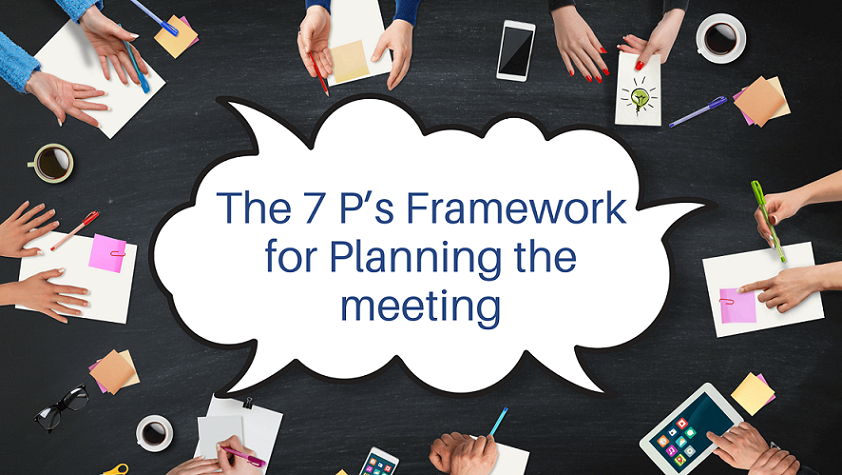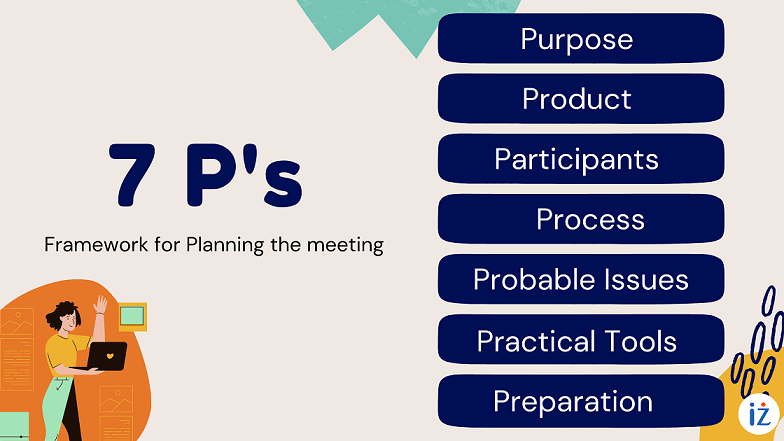

What do you feel when you attend an agenda-less meeting?
In my opinion, every meeting deserves a plan, and if attended by more than two people, it deserves serious planning.
The 7 P’s Framework gives you a structure to sketch your plan for the meeting.

What outcome would you like to achieve from this meeting?
If you are the meeting leader, you should be able to articulate the meeting’s purpose, urgency and impact.
If you organize it for others, you should make them come with purpose, urgency, and impact. If this is becoming difficult to articulate, think about if you need this meeting.
Different types of purposes may need a different structure for the meeting; a debriefing meeting gets organized very differently than a decision-making meeting.
To achieve the outcome of the meeting, you need some outputs, some specific artifacts. The artifacts which will get produced in the meeting can be known as the products of the meeting. The products (artifacts) helps in achieving the purpose of the meeting.
For example, you facilitate a meeting to align stakeholders on the project’s purpose, so a possible artifact is the Project Vision Statement. The absence of clarity on the product may result in “all talk and no follow-through.”
Who needs to attend this meeting to achieve the purpose of the meeting?
You may also think about what benefit the meeting attendees will get by attending.
You can imagine how difficult it will be to achieve the purpose of the meeting where people who have information or can make decisions are missing from the meeting. At the same time, if you invite people who are not related to the purpose of the meeting, they may derail the meeting.
As a facilitator, you need to identify the right participants and work with them in advance to clarify the purpose of the meeting and highlight their role in the meeting. Sharing a meeting plan with agenda in advance can help.
The Process can be understood as the plan of running the meeting from start to end. It lays out how the meeting will run to ensure the creation of quality products with full engagement from the participants.
The meeting agenda represents the Process; it should have the duration and structure of the meeting.
The Process is dependent on the rest of the 7Ps. Designing the agenda in advance in collaboration with meeting participants can increase engagement.
It is an excellent practice to review the agenda at the start of the meeting and be flexible to change it if the participants feel so. Some amount of adaption in the agenda can happen even when you are running the meeting.
What can go wrong, and how do you plan to respond to it?
This planning area can also become a place to reflect on all good practices one has to follow to overcome some of the frequent risks in running the meeting. In the case of reoccurring meetings, this area can include learning from past meeting experiences.
The tools you plan to use in the meeting, say projector, flip charts, some printed reports. Especially in virtual meetings, you may want to clarify/test the tool used for collaboration in advance.
There are two aspects to it, preparation done by the meeting facilitator and preparation done by the participants.
The meeting facilitator may need to prepare the place with all the necessary tools and ensure that information required for the meeting is readily available before the meeting to the participants so they can prepare for the meeting.
The meeting facilitator should also highlight the importance of preparation to the participants.

In today’s world, leaders are expected to do more and more facilitation to ensure engagement and creative problem-solving. Therefore, sharpening the facilitation skills is a good investment for leaders.
| Name | Date | Place | – |
| CSM Certification and Training | 12 – 13 April 2025 | Bangalore | More Details |
| CSM Certification and Training | 26 – 27 April 2025 | Pune | More Details |
| CSM Certification and Training | 3 – 4 May 2025 | Delhi | More Details |
No Trainings found